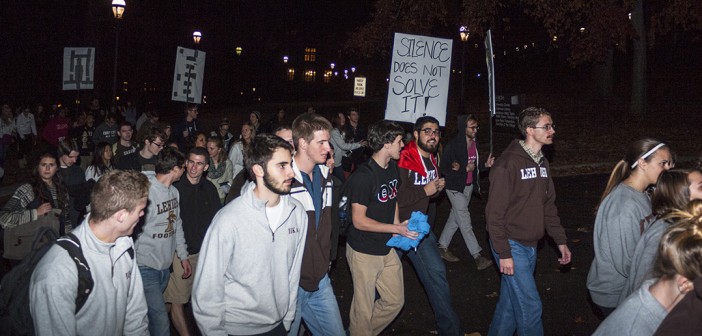After the class of 2017 graduates next May, there will few students on campus who were present for the racially charged events that occurred during the fall of 2013. But the legacy of that period of time at the university continues to influence the way Lehigh functions as an institution.
In October 2013, a student group called From Beneath the Rug protested and advocated on behalf of the voices of students who felt marginalized. The following month, individuals vandalized Lehigh’s Umoja House, a residence hall centered around the exploration of diversity and multiculturalism. The building was egged and spray-painted with racial slurs.
The response, a campus-wide rally, brought together more than 1,600 members of the Lehigh community. The rally was a call to action for a change in the university’s campus culture.
Chris Naunay, ‘16, a core member of From Beneath the Rug, said the campus climate was “tense” during the time of the Umoja incident.
“Students of different backgrounds were feeling very marginalized,” he said. “They weren’t able to speak for themselves, in a sense.”
He said the group was made up of students who had experienced situations that caused them to feel marginalized. Naunay’s own experience with racism was getting called a “spic” on multiple occasions while walking on East Fifth Street.
“At that moment I didn’t consider it to be as big as I thought it would be, just because it happened so quick, but that happened to me more than once,” he said. But From Beneath the Rug helped him connect with other students who shared similar experiences.
However, Naunay believes Lehigh did not respond strongly enough to the incidents in 2013 and the administration could still be doing more to foster a better atmosphere now.
“It’s more than just those incidents happening,” he said. “It’s something in Lehigh’s atmosphere (that) is allowing these feelings and allowing these actions to happen.”
In the time following the Umoja House incident, Lehigh took a variety of actions. The university held open forums, launched initiatives, hired new faculty and staff, revived the Council for Equity and Community, and renovated the vandalized house, among other efforts.
But now, three years later, conversations about handling diversity have quieted down and changed direction. With the introduction of campus initiatives to address inclusion, there’s been a shift in the dialogue surrounding these issues.
So what has changed in the past three years?
Gladys Castellon, ‘17, was a first-year student living in the Umoja House at the time of the incident.
“I think (Lehigh has) lost momentum,” she said. “Now that the issues that are going on aren’t as apparent and blatantly wrong, I think it’s easier for (the university) to take a step back and say we’re doing OK.”
Naunay said he feels as though Lehigh is pretty much the same as it was a few years ago, but not necessarily at the fault of the university. He said the institution can play a role in terms of perpetuating a negative campus climate, but students as individuals are also part of the equation.
Naunay said he sees students taking on responsibility for fostering a more inclusive campus environment. He said students are becoming more conscious of each other and their actions.
Castellon, however, said she thinks some people still aren’t cognizant of the fact that there are identities other than their own. The blame for this is not only on the institution, but also on the students.
“People aren’t egging the U-house, but people are still making comments,” Castellon said.
Tyrone Russell, the director of the Office of Multicultural Affairs, said the student body has started to think about how it is impacted by the lack of diversity and inclusion. More people are seeing themselves as part of that conversation.
“Different people are beginning to look at what it means to be a diverse and inclusive campus, beyond just students of color,” he said.
This shift toward more student awareness of campus climate may be in part due to the work of Karen Salvemini. Salvemini was hired in January 2015 as the university’s equal opportunity compliance coordinator. The role, while not required by Lehigh’s investigation by the Office for Civil Rights, was a position implemented in response to the investigation.
Over the past year of holding her position, she has worked to roll out harassment and discrimination training to various groups on campus. Working with Brooke DiSipio, the director of the Office of Gender Violence Education and Support, Salvemini has presented to varsity athletic teams and Greek chapters.
“Engaging people in thinking about these topics and giving more input, I think, is really important,” Salvemini said. “I think those conversations are starting to happen more, and people are feeling more comfortable having those kind of conversations.”
Salvemini has been working on communicating with different groups on campus to continue rolling out the training, both online and in person, to a variety of campus constituencies such as graduate students, student clubs, club sports and more.
She has seen a significant jump in the number of incidents reported this year, which she said is a testament to this spread of information.
“There’s been a lot of movement in the right direction, and we just want to make sure that doesn’t stop,” Salvemini said.
While there has been progress, Russell said Lehigh still needs to work on considering different views when making decisions.
“We need to make sure that voices that we don’t represent sit at the table to help us make those decisions,” he said. He also noted sometimes students are more open than faculty and staff to learn more and make a change on campus.
Castellon echoed this sentiment. She said the biggest problem she still sees on campus is the lack of consideration of impact of the decisions on the entire campus community, including minorities.
“If (the institution’s) focus was really on the students, I think decisions would be made differently,” Castellon said. “Not just benefiting the institution as a whole or just a few people.”
She said she would like to see students of different identities become an increasingly important part of dialogues and conversations on campus.
Russell said he sees the Council for Equity and Community, a Lehigh committee serving as an agent of cultural change, poised to be a sounding board for discussions of diversity and inclusion. The council is in the middle of conducting a diversity audit to get a sense of what groups across campus are doing in terms of diversity and inclusion programming, training and other educational efforts.
“I don’t think this work is ever done,” Salvemini, who is a member of the council, said. “I think it’s constantly trying to encourage people to talk about these issues, talk about these topics, encourage people to intervene.”
Naunay and Castellon both said the Lehigh University Summer Scholars Institute, organized by Russell, is a step in the right direction. The program is for incoming first-year students — many of them are first-generation college students — who show much promise in the areas of leadership and civic engagement.
Russell said the Summer Scholars Institute has created students who are highly involved on campus and have a sense of belonging. He also said Lehigh’s implementation of the LeaderShape program has helped to increase the number of students on campus who want to spark change.
Naunay also said Lehigh’s recent commitment to meet 100 percent of every student’s demonstrated financial need is another good initiative for students who may not be able to afford higher education. He said many of the marginalized groups he interacted with during the time of From Beneath the Rug were students who felt underrepresented from a financial standpoint.
“Obviously, there’s still a lot of work to be done, but when you’re thinking about inclusion and making Lehigh an excellent educational institution, it’s never going to be done,” Russell said.






Comment policy
Comments posted to The Brown and White website are reviewed by a moderator before being approved. Incendiary speech or harassing language, including comments targeted at individuals, may be deemed unacceptable and not published. Spam and other soliciting will also be declined.
The Brown and White also reserves the right to not publish entirely anonymous comments.